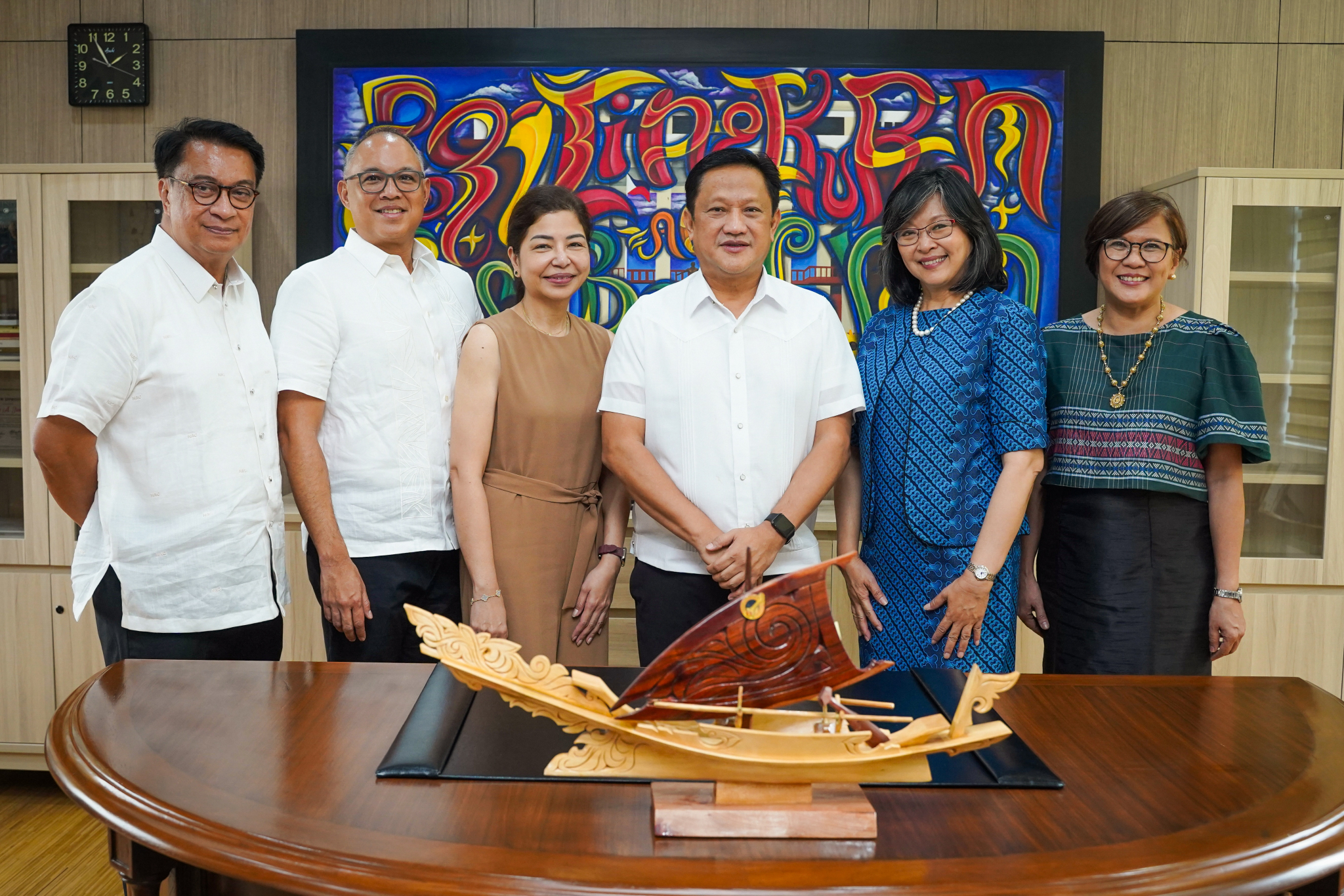Listed natural resources development company, Nickel Asia Corp. (NAC) has donated ₱50 million to the University of the Philippines National Institutes of Health (NIH) - the country's leading institution for health research and development.

From left to right: NACFI President Jose Bayani Baylon, NAC President and CEO Martin Antonio G. Zamora, NAC Vice Chairman Patricia Riingen, UP President Atty. Angelo A. Jimenez, National Scientist and former Chancellor of UP Manila Dr. Carmencita Padilla, and NIH Executive Director Dr. Eva Maria Cutiongco-de la Paz.
The donation, from the newly-established Nickel Asia Corp. Foundation Inc. (NACFI) will fund the unique design plan of the 19-level NIH building – the first high-rise research laboratory facility in the country.
It will also be the tallest “all-steel” building structure using the special concentrically braced framing system. This is one of the biggest endeavors of the UP System since its establishment in 1908.
“We are immensely grateful for this partnership we have forged with Nickel Asia. The completion of the NIH building will be a medical and research breakthrough that will lead to enormous savings to millions of Filipinos,” said UP President Atty. Angelo A. Jimenez.
The UP President has included “Research and Innovative Collaborations through Research Groups/Creative Studios and Technology Transfers” as one of UP’s flagship programs. This flagship program aims to establish UP as a hub of innovation by fostering a robust ecosystem that facilitates the commercialization of research outputs and nurtures startups.
Dr. Eva Maria Cutiongco-de la Paz, Executive Director of the NIH, stated that the P50-million donation from NACFI allows UP to get the top professionals to design the building and create an infrastructure that could serve the country’s need for research for better health and wellness for Filipinos.
Multiplier effect
“We decided to help NIH because research has a multiplier effect that you cannot get from conducting medical missions or providing free healthcare – both of which are something we are already doing through NAC,” said NACFI President Jose Bayani Baylon.
“We believe that access to quality healthcare is a right, and as part of our commitment to the United Nations Sustainable Development Goals, we will continue to support institutions like NIH to promote access to good healthcare and well-being,” stressed Baylon, who is also the Company’s Chief Sustainability Officer.
NACFI, the philanthropic arm of NAC, intends to support two focus areas – health and education.
Its mission is to support activities within and beyond its mining communities that would nurture a spirit of accountability and improvement of living standards over the long term.
UP Vice President for Academic Affairs Dr. Leo DP Cubillan, who also served as Director of the NIH - Philippine Eye Research Institute, emphasized that a Filipino family is one major illness away from bankruptcy, noting the importance of providing basic healthcare to all.
“The donation of NAC does not only make them our sponsors but our partners in delivering what we need to do in NIH. Through quality research, we’ll be able to improve the way we treat our patients and pass on these discoveries to the next generation so that they can continue to improve the field of medicine,” Cubillan said.
“According to Hippocrates, the Father of Medicine, the promise of medicine is to cure sometimes, treat often, and comfort always. As doctors, that is what we do on a day-to-day basis. Here in the Philippines, 60 percent of Filipinos cannot afford basic healthcare. Through research, we are able to at least bridge that gap through providing affordable alternative medicines, portable equipment, and lobbying for policies that can afford everyone some basic health services,” he added.
Creating a lasting impact
Through NACFI, NAC President and CEO Martin Antonio G. Zamora said the NAC Group will be able to focus on areas that are not in its communities and not covered by government-mandated Social Development and Management Programs and Corporate Social Responsibility projects.
“We would like to focus on impact and not just good headlines. NIH has given us the opportunity to do exactly just that. Like NIH, we believe in the power of research and its intergenerational impact. This is just the start,” he said. National Scientist and former Chancellor of UP Manila Dr. Carmencita Padilla shared the efforts of the past administrations to raise funds for a new NIH building. She underscored that with the help of Trade Secretary and former UP President Alfredo Pascual, ₱1 billion was allotted in the national government’s 2012 budget for its construction.
“We have been looking forward to a home where we can be on one roof, where we can interact with each other and have meaningful research collaborations that can be translated to health policies, programs, and products for the Filipino people,” she declared.
The new NIH building will be a P2.5-billion facility with 38,500 square meters of clinical research infrastructure using ultramodern, resilient, and sustainable design.
It will also have an Animal Research Center for small-sized laboratory animals which will promote evidence-based research with animal experiments seeking novel treatments and vaccines for various diseases.
Medical breakthroughs
NIH is home to 11 institutes and five centers, namely: the Philippine Eye Research Institute, National Institute of Molecular Biology and Biotechnology, Institute of Clinical Epidemiology, National Telehealth Center, Institute of Pharmaceutical Sciences, Institute of Human Genetics, Institute of Child Health and Human Development, Institute of Health Policy and Development Studies, Philippine National Ear Institute, Newborn Screening Reference Center, Newborn Hearing Screening Reference Center, Institute of Herbal Medicine, Institute on Aging, National Training Center for Biosafety and Biosecurity, National Clinical Trials and Translation Center and the Institute of Reproductive Health.
In addition, it consists of 17 active study group focusing on vaccine; child abuse, neglect, and exploitation; health emergencies and disasters; HIV/AIDS; injury prevention and control; vasculitis; neglected tropical diseases; bioethics; nursing development; advanced studies and research in orthopedics; oral health; rational drug use; tuberculosis; musculoskeletal tumor; colorectal polyp and cancer; and enteric diseases.
NIH, through several studies and research, has continually made its mark in the Philippines’ health research. Significant research output from these institutes have produced several health-related policies with national impact – RA 9288 or “New-born Screening Act” in 2004, RA 9709 or “Universal Newborn Hearing Screening Act” in 2009, RA 10747 or “Rare Disease Act” in 2016, and most recently, RA 11358 or “National Vision Screening Act” in 2019.
The NIH has also contributed to the country’s efforts to build on basic scientific research to create new therapies, medical procedures, or diagnostics which can reach even the marginalized sector of society. Herbal medicines such as Lagundi and Sambong are now widely prescribed. Diagnostic kits for infectious diseases such as dengue has provided affordable access to the molecular-based technologies in areas deprived of advanced clinical laboratories. The RxBox, a biomedical device, electronic medical record system and used for telemedicine, is designed to provide better access to life-saving healthcare services in isolated and disadvantaged communities nationwide.
Scientists from the National Institutes of Health were also at the forefront of providing solutions to the challenges posed by the pandemic. The GenAmplifyTM COVID-19 RT-PCR Detection Kit was developed as a low-cost technology for the detection of SARS-CoV2, a big step for the country to achieve self-sufficiency in addressing the pandemic. The Philippine COVID-19 Living Recommendations were also developed at the NIH in partnership with DOH, DOST, and medical societies, and in collaboration with the World Health Organization (WHO), the NIH led the Solidarity Trial and Convalescent Plasma Trial.
Other major contributions of the National Institutes of Health are as follows: National Clinical Practice Guidelines, National Unified Health Research Agenda, Vaccine Effectiveness Trials for Dengue Vaccine and COVID-19 Vaccines, Telemedicine Practice Guidelines, FIT for FRAIL: Focused InTerventions for FRAIL Older Adults Research and Development Program, Dementia Tool Kit, National Cochlear Implant Program, Precision Medicine Initiatives for Cardiovascular Disease, Diabetes and Cancer.



